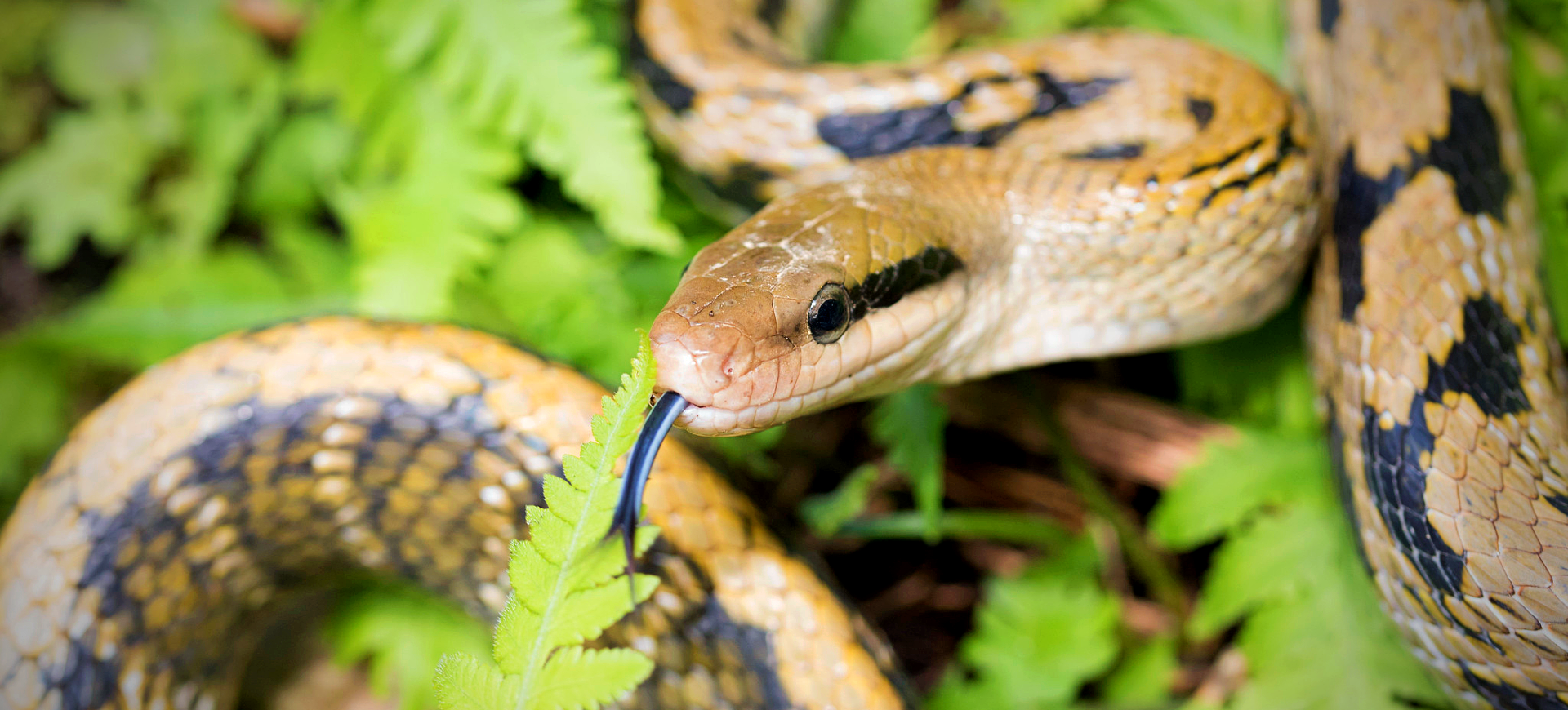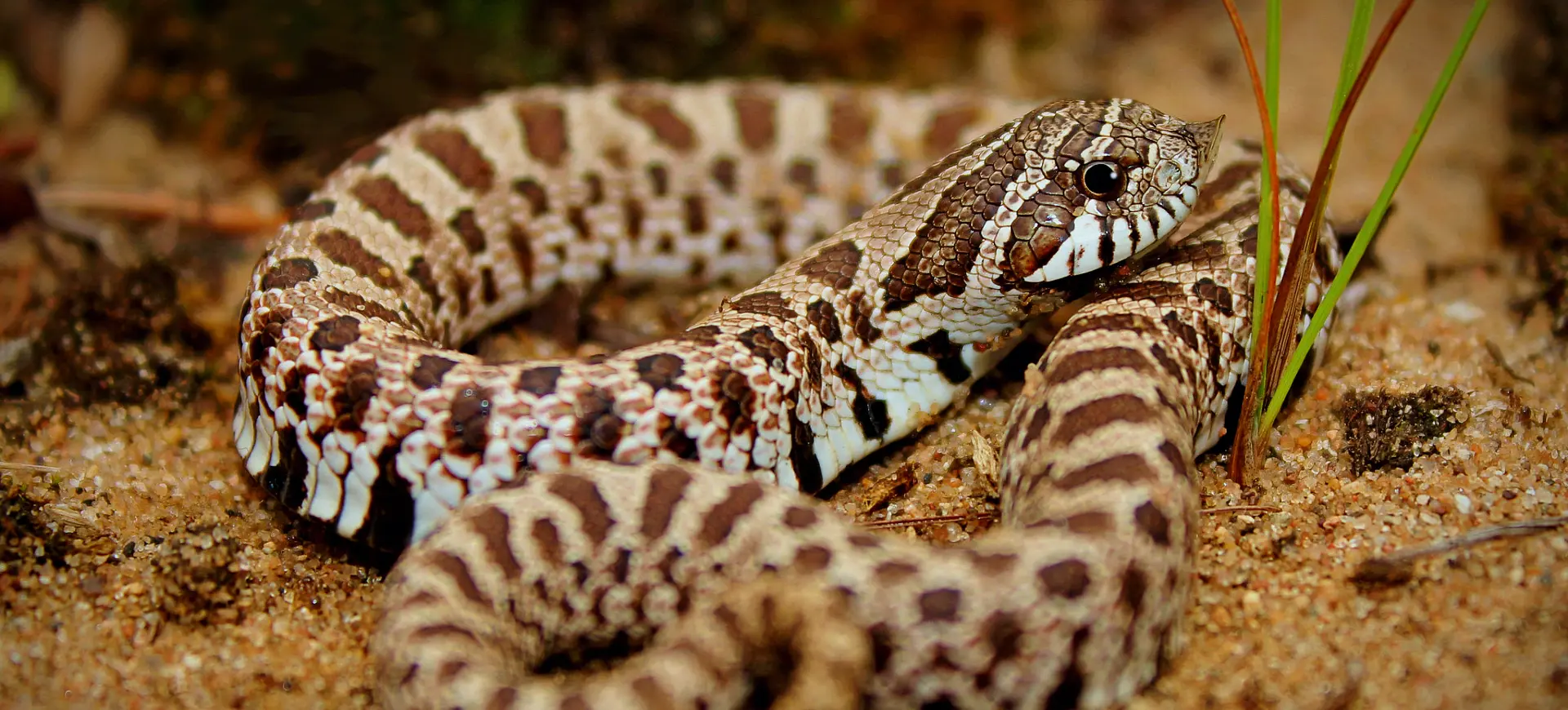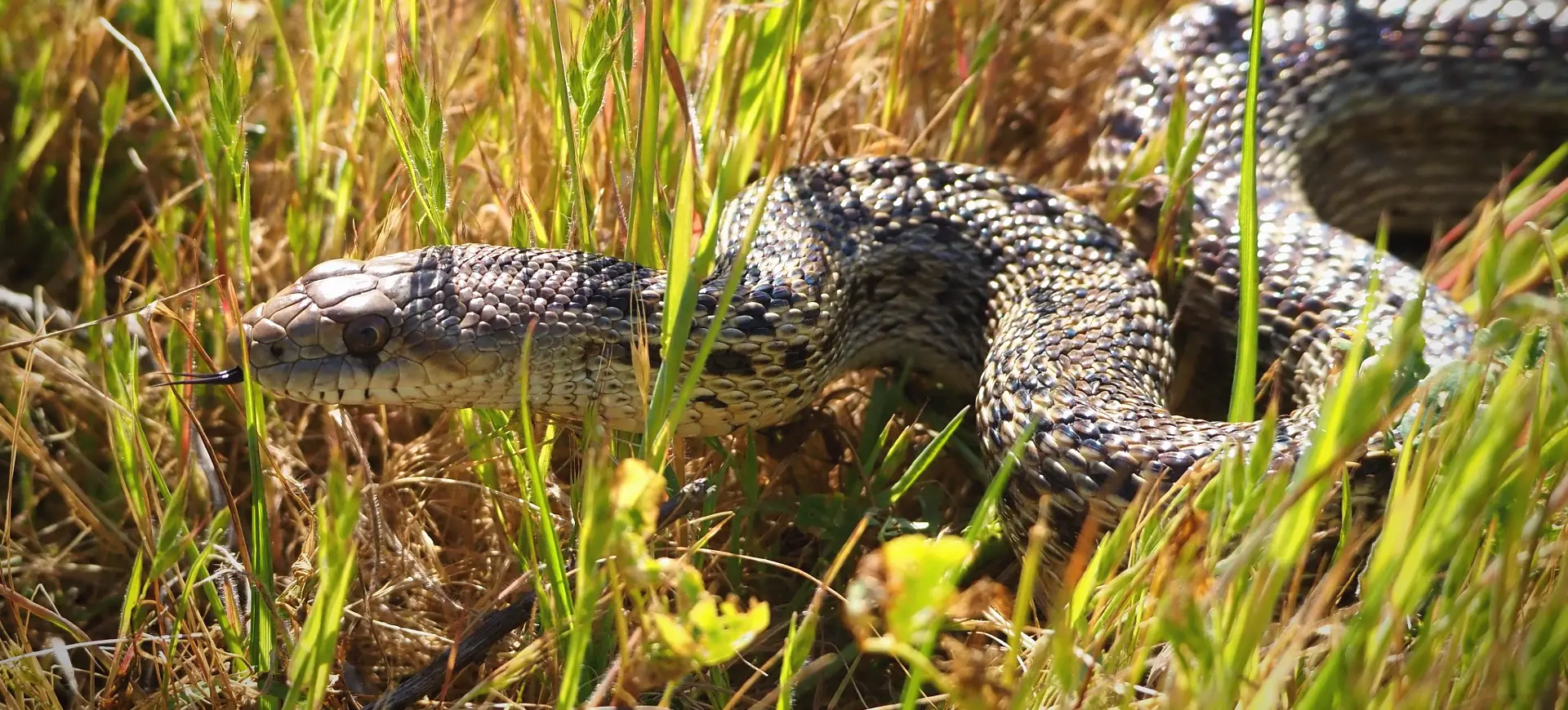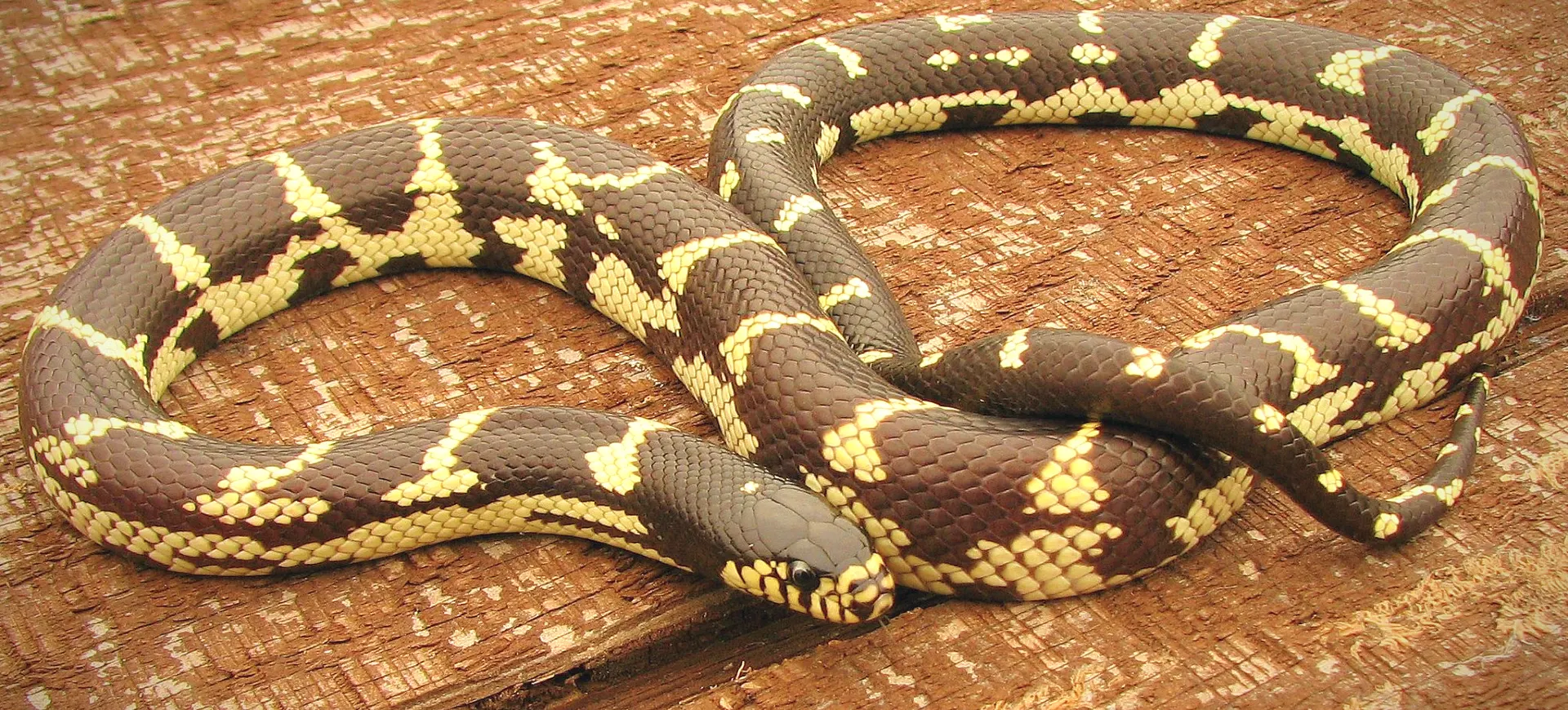Overview
The Common Garter Snake is one of North America’s most widespread and recognizable snake species, found in various habitats ranging from wetlands to forests and grasslands. It is known for its distinctive stripes, which run along the length of its body, and its adaptability to rural and urban environments. These snakes are generally harmless to humans and are often seen basking in the sun near water bodies or hiding under rocks and logs. Common Garter Snakes are active during the day and are known for their ability to swim, making them versatile hunters of small prey such as amphibians, fish, and invertebrates.
They play a crucial ecological role as both predators and prey, helping to control populations of pests like slugs and small rodents. When threatened, they may release a foul-smelling musk to deter predators, and although non-venomous, they can deliver a mild bite if handled roughly. These snakes are highly adaptable, surviving in various climates, from the cool northern regions to warmer southern areas. Due to their widespread distribution, they are often the first snakes that people encounter, making them a common subject of interest for nature enthusiasts and herpetologists alike.
Common Garter Snakes are also known for their social behavior during the winter when they gather in large numbers in communal hibernation sites called hibernacula. During the spring, they emerge from hibernation and engage in a frantic mating period, often forming “mating balls” where multiple males compete to mate with a single female. Their coloration and patterns can vary greatly depending on the subspecies and locality, with some individuals displaying bright red or yellow stripes. In contrast, others may have more muted or brownish tones. These variations allow them to blend into different environments, aiding in camouflage from predators.
Taxonomy
Kingdom
Phylum
Class
Order
Family
Genus
Species
Type
Current distribution:
The Common Garter Snake is widely distributed across North America, from southern Canada through most of the United States to parts of Mexico. It is found in almost every state in the U.S. except arid desert regions and extremely cold areas, where it cannot survive harsh conditions. Its northernmost range extends into southern parts of Canada, where it hibernates to survive the colder winters. This species' adaptability allows it to occupy a diverse range of habitats, contributing to its presence in both rural and urban environments.
They are commonly seen in areas with abundant water sources, such as along the edges of ponds, marshes, and streams, as well as in fields and forests. Urban sprawl and habitat alteration have led to some local declines, but the species remains common and widespread overall. Despite this, habitat fragmentation can lead to isolated populations, which may become more vulnerable to local extinction if their environment changes. Conservation of wetland habitats is important for maintaining healthy populations of Common Garter Snakes, particularly in areas where development is encroaching on natural spaces.
Physical Description:
The Common Garter Snake is a medium-sized snake with a slender, elongated body that can vary greatly in color and pattern depending on the subspecies and region. Typically, they have three light-colored stripes running lengthwise down their bodies, which are often yellow, greenish, or white, set against a darker black, brown, or olive background. Some populations, like the San Francisco Garter Snake, exhibit more vivid coloration, including bright red and blue stripes. Their scales are keeled, giving them a slightly rough texture, which helps them move efficiently through various terrains.
The head of the Common Garter Snake is usually broader than its neck, and it has round pupils with relatively large eyes for its size, aiding in its vision during hunting. The underside is generally lighter, often white, pale yellow, or greenish, and can be faintly patterned. Juvenile garter snakes resemble adults but may have more pronounced striping and colors. Overall, their coloration and patterns provide excellent camouflage in their natural habitats, helping them avoid detection by both predators and prey.

Lifespan: Wild: ~4 Years || Captivity: ~10 Years

Weight: Male & Female: 5.3-17.6 oz (150-500 g)

Length: Male & Female: 18-54 in (46-137 cm)

Top Speed: 4 mph (6.4 km/h)
Characteristic:
Native Habitat:
Common Garter Snakes are highly adaptable and can be found in various habitats, including wetlands, grasslands, forests, and even suburban areas. They prefer environments close to water sources, such as ponds, streams, marshes, and ditches, where they can easily find amphibians and fish. They are also comfortable in meadows and woodlands, where they hunt earthworms, insects, and small mammals. During the colder months, they retreat to underground hibernation sites, often shared with other snakes and located in rock crevices, rodent burrows, or human-made structures.
Their adaptability has allowed them to thrive in urban and agricultural settings, where they can often be found in gardens, parks, and fields. These diurnal snakes can frequently be seen basking in the sun on rocks, logs, and roadsides to regulate their body temperature. In hotter climates, they may become more crepuscular or even nocturnal to avoid the midday heat. This flexibility in habitat choice and behavior has contributed to the widespread distribution and success of the Common Garter Snake across North America.
Climate Zones:
Biogeographical Realms:
Continents:
Countries:
Diet:
Diet & Feeding Habits:
Common Garter Snakes are opportunistic carnivores that feed on a wide range of prey, depending on availability. Their diet primarily consists of amphibians such as frogs and toads, but they also eat small fish, earthworms, slugs, and occasionally small mammals. Due to their mild resistance to certain toxins found in some prey species, they are known for their ability to eat prey that other predators avoid, such as toxic amphibians. Garter snakes use a combination of ambush and active hunting techniques, relying on their keen sense of smell and ability to track chemical trails to locate prey.
These snakes are capable swimmers and can catch fish and amphibians in the water, distinguishing them from other terrestrial snakes. They often hunt along the edges of ponds, marshes, and streams where their prey is abundant. Unlike other snake species, they do not constrict their prey; instead, they use quick, precise strikes to grab and swallow it whole. In captivity, they can be fed a diet of appropriately sized fish, amphibians, and sometimes pre-killed mice, though a varied diet is important to maintain their health.
Mating Behavior:
Mating Description:
The Common Garter Snake is known for its unique mating behavior, where large numbers of males emerge from hibernation sites in the spring and compete for a single female in what is called a “mating ball.” During this time, several males will attempt to mate with one female, resulting in a writhing mass of snakes. Mating usually occurs shortly after they emerge from hibernation, and the female stores the sperm to fertilize her eggs later, allowing her to control the timing of reproduction. Females give birth to live young in late summer or early fall, with litters ranging from 10 to 40 offspring.
The young are born fully developed and independent, receiving no parental care after birth. They can immediately fend for themselves and begin hunting small prey such as insects and earthworms. This reproductive strategy, where many young are produced at once, helps to ensure that at least some will survive to adulthood despite high predation rates. The timing of mating and birth is influenced by environmental factors such as temperature and food availability, which affect the success of the offspring.
Reproduction Season:
Birth Type:
Pregnancy Duration:
Female Name:
Male Name:
Baby Name:
Social Structure Description:
Common Garter Snakes are generally solitary, except during the breeding season when they gather in large numbers at hibernation sites. During the winter, they brumate in communal dens known as hibernacula, which may be shared with other snake species, sometimes numbering in the hundreds. This behavior provides warmth and protection during the cold months, and these communal gatherings play a significant role in their social structure, as they often lead directly to mating activities in the spring. Outside of these periods, garter snakes are typically solitary hunters.
They use a variety of defensive behaviors to avoid predation, including releasing a foul-smelling musk and flattening their bodies to appear larger. Although they can be territorial during the breeding season, their encounters are usually brief and not aggressive. Communication between individuals is primarily through chemical signals, which play a critical role in mating and locating hibernation sites. This social behavior allows them to effectively find mates and suitable locations to survive the winter months, showcasing cooperation not often seen in solitary reptiles.
Groups:
Conservation Status:
Population Trend:
The Common Garter Snake is listed as “Least Concern” due to its wide distribution and large, stable population across much of its range. It is one of North America’s most commonly encountered snakes, often seen in backyards, parks, and other areas where humans live and work. Despite its abundance, localized threats such as habitat loss, road mortality, and pesticide use can impact populations, particularly in urban and agricultural areas. Efforts to preserve wetland habitats are crucial in ensuring the continued survival of this species, as these environments are vital for their breeding and feeding.
The adaptability of Common Garter Snakes has allowed them to thrive even in disturbed environments, but isolated populations may be vulnerable to genetic bottlenecks. In some areas, particularly near urban centers, increased development can lead to habitat fragmentation, affecting movement and resource access. Conservation measures that maintain connectivity between habitats, such as wildlife corridors, benefit these snakes. Overall, their flexible behavior and diverse diet have made them one of North America’s most successful snake species.
Population Threats:
The main threats to Common Garter Snakes include habitat loss and fragmentation due to urban expansion, agriculture, and road construction. Pesticide use is also a significant concern, as it can reduce their prey populations, particularly amphibians and insects. Road mortality is another issue, as these snakes are often found basking on warm roads and can be hit by vehicles. Despite these threats, their adaptability has allowed them to persist in many environments where other species might decline.
Climate change could also pose a future threat by altering the availability of water sources and suitable habitats. In areas where they are popular in the pet trade, illegal collection from the wild can lead to declines in the local population. Public misperceptions about snakes often lead to unnecessary killing, even though Common Garter Snakes are harmless and beneficial to ecosystems. Conservation programs focusing on habitat preservation, education, and responsible pet ownership are key to mitigating these threats.
Conservation Efforts:
Conservation efforts for Common Garter Snakes include habitat preservation, particularly of wetlands, which are crucial for survival. Wildlife organizations promote the protection of ponds, marshes, and grasslands that serve as breeding and feeding grounds for these snakes. Public education campaigns aim to reduce the unnecessary killing of snakes by helping people distinguish between harmless garter snakes and potentially dangerous species. In addition, efforts to create wildlife corridors can help maintain connectivity between habitats, which is important for snake populations’ movement and genetic diversity.
Programs that encourage responsible pesticide use and the protection of amphibian populations also benefit Common Garter Snakes by ensuring a stable food supply. There is also an emphasis on reducing road mortality by constructing underpasses and signage to alert drivers in areas with high snake activity. In regions where they are kept as pets, education on responsible care helps reduce the release of captive snakes into the wild, which can lead to issues with disease transmission. Overall, the conservation of Common Garter Snakes is tied to broader efforts to protect and manage North American wetlands and natural habitats.
Additional Resources:
Fun Facts
- Common Garter Snakes are among the few snake species in North America that give birth to live young.
- They are mildly resistant to the toxins of some amphibians, allowing them to prey on species that are dangerous to other predators.
- Their name, “garter,” comes from their stripe pattern, which resembles garters that were once used to hold up stockings.
- Garter snakes can detect chemical trails left by other animals, which helps them locate prey and mates.
- During the spring, males emerge from hibernation before females, often forming large “mating balls” around a single female.
- They are excellent swimmers and are often seen hunting in or near water.
- These snakes can release a foul-smelling musk from their cloaca to deter predators when threatened.
- Despite their harmless nature, they are often mistaken for more dangerous snakes and are sometimes killed unnecessarily.
- Garter snakes can survive in various environments, from coastal wetlands to mountain meadows.
- They are known to hibernate in large communal dens in cooler regions, sometimes with other snake species.



















